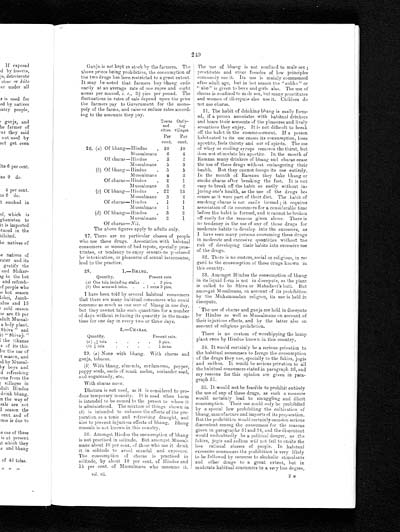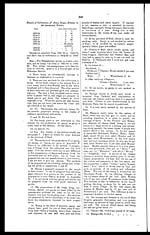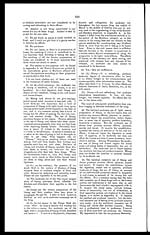Medicine - Drugs > Report of the Indian Hemp Drugs Commission, 1894-1895 > Volume VII > Evidence of Sind witnesses
(267) Page 249
Download files
Individual page:
Thumbnail gallery: Grid view | List view

249
Ganja is not kept in stock by the farmers. The
above prices being prohibitive, the consumption of
the two drugs has been restricted to a great extent.
It may be noted that farmers buy bhang ordi-
narily at an average rate of one rupee and eight
annas per maund, i.e., 33/5pies. per pound. The
fluctuations in rates of sale depend upon the price
the farmers pay to Government for the mono-
poly of the farms, and raise or reduce rates accord-
ing to the amounts they pay.
| Towns and cities. Per cent. |
Outly- ing villages. Per cent. |
||||
| 26. | (a) | Of bhang—Hindus | 20 | 10 | |
| Mussalmans | 6 | 4 | |||
| Of charas—Hindus | 3 | 2 | |||
| Mussalmans | 5 | 3 | |||
| (b) | Of bhang—Hindus | 5 | 5 | ||
| Mussalmans | 4 | 3 | |||
| Of charas—Hindus | 2 | 1 | |||
| Mussalmans | 3 | 2 | |||
| (c) | Of bhang—Hindus | 22 | 13 | ||
| Mussalmans | 3 | 2 | |||
| Of charas—Hindus | 1 | 1 | |||
| Mussalmans | 1 | 1 | |||
| (d) | Of bhang—Hindus | 3 | 2 | ||
| Mussalmans | 2 | 1 | |||
| Of charas—Nil. |
The above figures apply to adults only.
27. There are no particular classes of people
who use these drugs. Association with habitual
consumers or women of bad repute, specially pros-
titutes, or tendency to enjoy sensations produced
by intoxication, or pleasures of sexual intercourse,
lead to the practice.
28.
| 1.—BHANG. | |||
| Quantity. | Present rate. | ||
| (a) | One tola including stalks | 3 pies. | |
| (b) | One anna =5 tolas. | 1 anna 3 pies. | |
I have been told by several habitual consumers
that there are many habitual consumers who could
consume as much as one seer of bhang in one day,
but they cannot take such quantities for a number
of days without reducing its quantity in the mean-
time for one day in every two or three days.
| 2.—CHARAS. | |||||
| Quantity. | Present rate. | ||||
| (a) 11/6 tola | 3 pies. | ||||
| (b) ¼ tola | 1 anna. | ||||
29. (a) None with bhang. With charas and
ganja, tobacco.
(b) With bhang, almonds, cardamoms, pepper,
poppy seeds, seeds of musk melon, coriander seed,
and sugarcandy, etc.
With charas none.
Dhatura is not used, as it is considered to pro-
duce temporary insanity. It is used when harm
is intended to be caused to the person to whom it
is administered. The mixture of things shown in
(b) is intended to enhance the effects of the pre-
paration as a tonic and refreshing draught, and
also to prevent injurious effects of bhang. Bhaug
massala is not known in this country.
30. Amongst Hindus the consumption of bhang
is not practised in solitude. But amongst Mussal-
mans about 10 per cent. of those who use it drink
it in solitude to avoid scandal and exposure.
The consumption of charas is practised in
solitude, by about 10 per cent. of Hindus and
15 per cent. of Mussalmans who consume it.
The use of bhang is not confined to male sex;
prostitutes and other females of low principles
commonly use it. Its use is mainly commenced
after adult age, but in hot season the " sukho " or
"abo" is given to boys and girls also. The use of
charas is confined to male sex, but many prostitutes
and women of ill-repute also use it. Children do
not use charas.
31. The habit of drinking bhang is easily form-
ed, if a person associates with habitual drinkers
and hears their accounts of the pleasures and lively
sensations they enjoy. It is not difficult to break
off the habit in the commencement. If a person
habituated to its use ceases its consumption, loses
appetite, feels thirsty and out of spirits. The use
of whey or cooling syrups removes the thirst, but
does not stimulate his appetite. In the month of
Ramzan many drinkers of bhang and charas cease
the use of these drugs without endangering their
health. But they cannot forego its use entirely.
In the month of Ramzan they take bhang or
smoke charas after breaking the fast. It is not
easy to break off the habit so easily without in-
juring one's health, as the use of the drugs be-
comes as it were part of their diet. The habit of
smoking charas is not easily formed; it requires
association of its consumers for a considerable time
before the habit is formed, and it cannot be broken
off easily for the reasons given above. There is
no tendency in the use of any of these drugs for
moderate habits to develop into the excessive, as
I have seen many persons consuming these drugs
in moderate and excessive quantities without the
risk of developing their habits into excessive use
of the drugs.
32. There is no custom, social or religious, in re-
gard to the consumption of these drugs known in
this country.
33. Amongst Hindus the consumption of bhang
in its liquid form is not in disrepute, as the plant
is called to be Shiva or Mahadavi's buti. But
amongst Musalmans, on account of its prohibition
by the Muhammadan religion, its use is held in
disrepute.
The use of charas and ganja are held in disrepute
by Hindus as well as Mussalmans on account of
their injurious effects, and by the latter also on
account of religious prohibition.
There is no custom of worshipping the hemp
plant even by Hindus known in this country.
34. It would certainly be a serious privation to
the habitual consumers to forego the consumption
of the drugs they use, specially to the fakirs, jogis
and sadhus. It would be serious privation to all
the habitual consumers stated in paragraph 26, and
my reasons for this opinion are given in para-
graph 31.
35. It would not be feasible to prohibit entirely
the use of any of these drugs, as such a measure
would certainly lead to smuggling and illicit
consumption. Their use could only be prohibited
by a special law prohibiting the cultivation of
bhang, manufacture and imports of its preparation.
But the prohibition would certainly occasion serious
discontent among the consumers for the reasons
given in paragraphs 31 and 34, and the discontent
would undoubtedly be a political danger, as the
fakirs, jogis and sadhus will not fail to excite the
less rational classes of people. In habitual
excessive consumers the prohibition is very likely
to be followed by recourse to alcoholic stimulants
and other drugs to a great extent, but in
moderate habitual consumers to a very less degree,
vol. vii.
2 M
Set display mode to: Large image | Zoom image | Transcription
Images and transcriptions on this page, including medium image downloads, may be used under the Creative Commons Attribution 4.0 International Licence unless otherwise stated. ![]()
| India Papers > Medicine - Drugs > Report of the Indian Hemp Drugs Commission, 1894-1895 > Volume VII > Evidence of Sind witnesses > (267) Page 249 |
|---|
| Permanent URL | https://digital.nls.uk/74911374 |
|---|




